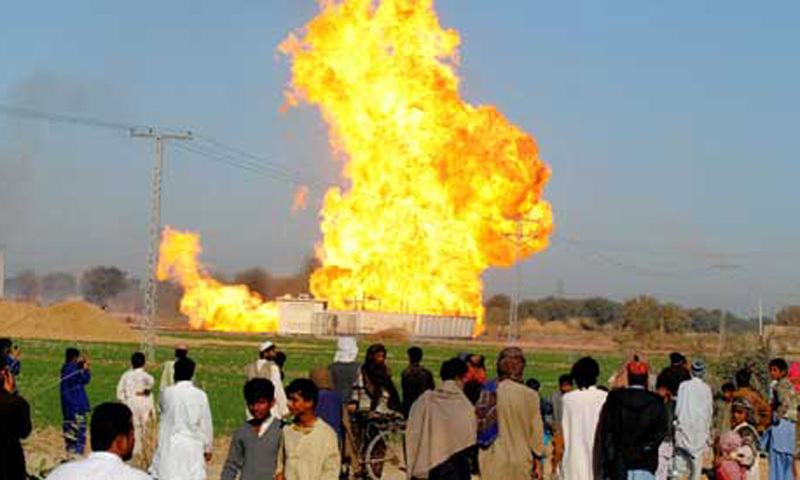A major gas transmission pipeline running from the Bettani oil field in Lakki Marwat to various regions in Punjab was targeted and blown up in the early hours of the morning, marking the third such incident within a month in the same area. The latest attack took place in the Wanda Amir (Torwah) region, under the jurisdiction of the Saddar Police Station in Lakki Marwat district. The repeated sabotage has raised deep concerns among authorities, energy officials, and residents who rely on this vital supply line for household and industrial gas needs.
Sequence of the Incident
Residents in the vicinity reported hearing a powerful explosion that shook the area before dawn. The explosion was so intense that it caused a significant rupture in the underground pipeline, releasing natural gas and igniting flames that could be seen from several kilometers away. Emergency response teams from the local administration and the Sui Northern Gas Pipelines Limited (SNGPL) were dispatched immediately to the site. They sealed off the affected section of the pipeline, halted gas transmission through the ruptured line, and began a preliminary assessment of the damage.
The sabotage not only destroyed a segment of the gas conduit but also disrupted supply to several downstream regions in Punjab. Industrial units, small businesses, and residential consumers in the receiving zones have already begun experiencing low pressure and intermittent gas outages. Restoration teams are on-site working under tight security, but the extent of the damage suggests that full restoration could take several days.
A Pattern of Escalating Sabotage
This latest explosion follows two previous attacks in the Wanda Amir and Jabbarkhel areas of Lakki Marwat on June 17 and June 27, respectively. All three attacks targeted the same strategic pipeline, which transports natural gas extracted from the oil-rich Bettani field to Punjab’s urban and rural centers. Authorities believe the pattern indicates deliberate and coordinated sabotage, rather than isolated incidents.
Experts point to the increasing frequency and precision of the attacks as signs of well-organized operations, possibly orchestrated by militant groups aiming to destabilize vital national infrastructure. The repeated targeting of this specific pipeline has not only affected energy supply but has also created an atmosphere of fear and uncertainty in the region.
Security Response and Ongoing Investigation
Law enforcement agencies, including the District Police Office (DPO) and counterterrorism units, have launched a full-scale investigation into the incident. Bomb disposal squads have cordoned off the area, while forensic teams are collecting samples and evidence from the blast site. Initial observations suggest the use of high-intensity improvised explosive devices (IEDs), strategically placed to maximize pipeline rupture without causing wider civilian damage.
Security forces have intensified patrols along the pipeline corridor and established temporary check posts to monitor movement in the area. Surveillance drones and aerial reconnaissance are being used to scan the difficult terrain for potential hideouts or escape routes used by the perpetrators. Intelligence agencies are also working on possible links between the attacks and known extremist elements operating in Khyber Pakhtunkhwa.
Impact on Energy Supply and Daily Life
The immediate consequence of the attack is the disruption of natural gas supply to parts of Punjab, including industrial zones and densely populated areas that depend heavily on continuous gas flow. Local industries especially those involved in textile, ceramics, and food production have expressed concern about production delays and increased operational costs due to the instability in gas supply. Domestic consumers, already coping with erratic electricity and fuel prices, now face another blow in the form of unreliable household gas.
Moreover, the cumulative effect of repeated pipeline sabotage is undermining public confidence in infrastructure security, not just in Khyber Pakhtunkhwa, but across the national energy grid. These attacks are contributing to an already fragile energy ecosystem, where shortages, pricing issues, and policy inefficiencies are compounding the burden on average citizens and small businesses alike.
Call for Long-Term Protective Measures
In response to the third blast, energy officials and regional administrators have renewed their call for urgent protective measures along Pakistan’s energy infrastructure. Suggested actions include:
- Enhanced physical security along pipeline routes, particularly in vulnerable regions.
- Installation of surveillance systems, including motion sensors, CCTV cameras, and aerial monitoring.
- Deployment of rapid response units trained to neutralize threats before damage occurs.
- Engagement with local communities to develop intelligence networks and improve awareness about suspicious activity.
- Policy-level coordination between federal, provincial, and private stakeholders to ensure sustainable energy protection frameworks.
Security analysts have warned that as militant groups evolve their tactics, energy infrastructure will remain a high-value target. With Pakistan’s heavy reliance on natural gas for domestic and industrial usage, ensuring the safety of transmission lines must now become a national priority.
Conclusion
The third attack in 30 days on a single pipeline corridor signals more than an isolated security lapse it reflects a growing threat to national stability and economic continuity. While repair work continues and security sweeps intensify, the long-term solution lies in a strategic overhaul of energy infrastructure protection, rooted in advanced technology, robust policing, and deep community engagement.
If left unchecked, such acts of sabotage could erode investor confidence, cripple energy-dependent industries, and further strain public services already operating under pressure. The time for reaction is over what is now needed is a proactive national strategy to defend Pakistan’s critical lifelines from the hands of destabilizing forces.



Comments (0)
No comments yet. Be the first to comment!
Leave a Comment